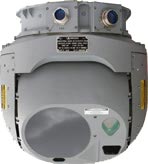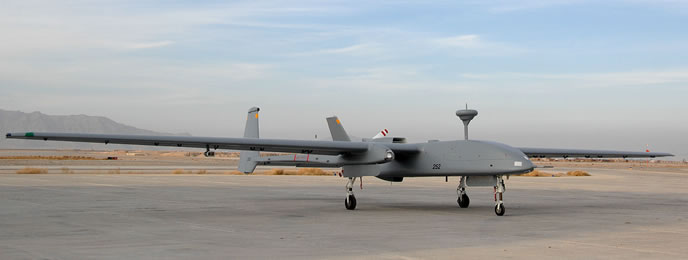Above: Heron 1 UAVs are operating successfuly in different regions, including Afghanistan, India and the Middle East. These aircraft can be configured with multiple payloads, comprising EO, radar, SIGINT and communications payloads. The video below shows IAI Heron in Canadian service.
Turkey has given the Israeli contractors IAI and Elbit Systems 50 days to fulfil a long-delayed deal for the delivery of 10 Heron unmanned aerial vehicles (UAVs) destined for the Turkish army. Despite the long delay, the Turkish military is still hopeful that deliveries could commence early in 2010.
This is not the first time Turkey is threatening such action. The Turkish Defense Procurement Agency (SSM) was decisive in canceling high profile programs, when unconvinced that programs are conducted satisfactorily. Few years ago, Turkey have cancelled a contract with Elbit Systems, claiming the Condor recce pod did not meet their requirements but two years later the Turks selected Elbit to provide a similar system.
The project, launched in 2005 has long been delayed for technical reasons but is currently in limbo, after the bilateral relations of the two countries have been derailed after the Turkish protest about the Israeli ‘Cast Lead’ operation in Gaza. The Turkish Government has signed a $183 million contract with a local industrial team formed by the Turkish firm Aselsan Electronics and a joint venture established by Israel Aerospace Industries and Elbit Systems. The JV has been given 50 days to fulfill the contract terms until the year’s end, or face cancellation.
Turks have acquired 10 Heron type UAVs, ground control and support systems. Three aircraft and one ground control system have already been supplied. One has crashed and the other grounded due to technical issues.
 Much of the problem was the Turkish decision to utilize the locally developed AselFlir 300T payload developed by Aselsan, instead of the Israeli built EO payloads, such the high performance MOSP and COMPASS lightweight integrated multi sensor systems, optimized for unmanned aircraft.
Much of the problem was the Turkish decision to utilize the locally developed AselFlir 300T payload developed by Aselsan, instead of the Israeli built EO payloads, such the high performance MOSP and COMPASS lightweight integrated multi sensor systems, optimized for unmanned aircraft.
Aselsan offers two EO payload types, the basic AselFlir 200 (photo on the far right column) weighing about 40 kg, and the 300T (top photo in the next column) weighing 93 kg. In comparison, IAI’s MOSP-3000 (photo above) weighs only 31 kg. while providing superior performance.


Back in 2005, Israel was offering multi-sensor EO payloads carrying FLIR, TV, laser rangefinder but was not offering laser designating UAV pods for export (a feature that the current MOSP 3000 supports as of 2009). The Turkish defense procurement agency (SSM) insisted on including the locally produced payload which could offer such capability, which left only the -300T model as a viable option. However, unlike the Israeli payload, the Turkish system was designed for helicopters and aircraft and was not specifically adapted for unmanned aircraft environment; weighing much more than the Israeli system, it exceeded the platform performance.
Carrying the heavier payload, the Heron must sacrifice performance, in terms of operating ceiling, and mission endurance, resulting in reduced operational survivability. The rift between the two sides remained about who will pay for the extra cost associated wit the necessary aircraft redesign.

















